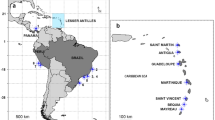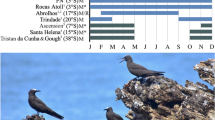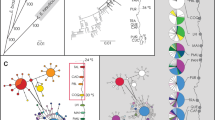Abstract
Although the genetic structure of many populations of marine organisms show little deviation from panmixia, in those marine species with limited larval dispersal, patterns of microgeographic genetic differentiation may be common. The octocoral Briareum asbestinum should show local population differentiation because colonies reproduce asexually by fragmentation, most matings occur between colonies in very close proximity, and the sexually produced larvae and sperm appear to disperse only short distances. Variability in secondary chemistry of individual B. asbestinum colonies from different populations in close proximity also suggests local population differentiation. We determined the genetic composition of local populations by surveying allozyme variation of three shallow and two deep populations within a 300 m2 area at San Salvador Island, Bahamas and at a site 161 km away on Little San Salvador, Bahamas in July 1990. As B. asbestinum occurs as either an erect branching form or an encrusting mat often at the same sites, we sampled both morphs to examine the extent of genetic exchange between them. Five of 21 loci were polymorphic and most populations showed a deficit of heterozygotes. Allele frequencies differed significantly between morphs at each site where they occurred together. The mean genetic distance (D=0.065) between morphs is consistent with the interpretation that the two morphs are genetically isolated. Despite the close spatial proximity of the San Salvador populations, both the branching and encrusting morphs showed significant genetic heterogeneity among neighboring populations. Similarly, pooled allelic frequencies for samples collected from the islands of San Salvador and Little San Salvador differed significantly at 1 locus for the branching morph and at 3 out of 5 loci for the encrusting morph.
Similar content being viewed by others
References
Ayre DJ (1984) The effects of sexual and asexual reproduction on geographic variation in the sea anemone Actinia tenebrosa. Oecologia 62:222–229
Ayre DJ (1985) Localized adaptation of clones of the sea anemone Actinia tenebrosa. Evolution 39:1250–1260
Ayre DJ, Read J, Wishart J (1991) Genetic subdivision within the eastern Australian population of the sea anemone Actinia tenebrosa. Mar Biol 109:379–390
Ayre DJ, Willis BL (1988) Population structure in the coral Pavona cactus: clonal genotypes show little phenotypic plasticity. Mar Biol 99:495–505
Bayer FM (1961) The shallow-water octocorallia of the West Indian region. Martinus Nijhoff, The Hague, Holland
Black R, Johnson MS (1979) Asexual viviparity and population genetics of Actinia tenebrosa. Mar Biol 53:27–31
Brazeau DA, Lasker HR (1990) Sexual reproduction and external brooding by the Caribbean gorgonian Briareum asbestinum. Mar Biol 104:465–474
Brazeau DA, Lasker HR (1992a) Reproductive success in the Caribbean octocoral Briareum asbestinum. Mar Biol 114:157–163
Brazeau DA, Lasker HR (1992b) Growth rates and growth strategy in a clonal marine invertebrate, the Caribbean octocoral Briareum asbestinum. Biol Bull mar biol Lab, Woods Hole 183:269–277
Bucklin A, Hedgecock D (1982) Biochemical genetic evidence for a third species of Metridium (Coelenterata: Actiniaria). Mar Biol 66:1–7
Coffroth MA, Lasker HR, Diamond ME, Bruenn JA, Bermingham E (1992) DNA fingerprints of a gorgonian coral: a method for detecting clonal structure in a vegetative species. Mar Biol 114:317–325
Davis AB, Butler AJ (1989) Direct observations of larval dispersal in the colonial ascidian Podoclavella moluccensis Sluiter: evidence for closed populations. J exp mar Biol Ecol 127:189–203
Gartner-Kepkay KE, Zouros E, Dickie LM, Freeman KR (1983) Genetic differentiation in the face of gene flow: a study of mussel populations from a single Nova Scotian embayment. Can J Fish aquat Sciences 40:443–451
Grosberg RK (1987) Limited dispersal and proximity-dependent mating success in the colonial ascidian Botryllus schlosseri. Evolution 41:372–384
Grosberg RK (1991) Sperm-mediated gene flow and the genetic structure of a population of the colonial ascidian Botryllus schlosseri. Evolution 45:130–142
Harris H, Hopkinson DA (1976) Handbook of enzyme electrophoresis in human genetics. North-Holland, Amsterdam
Harvell CD, Fenical W, Roussis V, Rousink JL, Griggs CC, Greene CH (1993a) Variation in the defensive chemistry of a West Indian gorgonian coral: environmentally induced or genetically fixed? Mar Ecol Prog Ser 93:165–173
Harvell CD, West J, Walls MA, Ruesink JL (1993b) Morphological plasticity and variation in reproductive traits of a gorgonian coral over a depth cline. Mar Ecol Prog Ser 94:61–69
Hebert PDN, Beaton MJ (1989) Methodologies for allozyme analysis using cellulose acetate electrophoresis. Helena Laboratories, Beaumont, Texas
Hedgecock D (1982) Genetic consequences of larval retention: theoretical and methodological aspects. In: V.S. Kennedy (ed.) Estuarine comparisons. Academic Press, New York, pp 553–568
Hedgecock D (1986) Is gene flow from pelagic larval dispersal important in the adaptation and evolution of marine invertebrates? Bull mar Sci 39:550–564
Hedgecock D, Tracy ML, Nelson K (1982) Genetics. In: Abele LG (ed.) Biology of the Crustacea. Vol. 2. Academic Press, New York, pp 283–403
Hoffmann RJ (1976) Genetics and asexual reproduction of the sea anemone Metridium senile. Biol Bull mar biol Lab, Woods Hole 151:478–488
Hoffmann RJ (1986) Variation in contributions of asexual reproduction to the genetic structure of populations of the sea anemone Metridium senile. Evolution 40:357–365
Hoffmann RJ (1987) Short-term stability of genetic structure in populations of the sea anemone Metridium senile. Mar Biol 93:499–507
Jackson JBC (1986) Modes of dispersal of clonal benthic invertebrates: consequences for species distributions and genetic structure of local populations. Bull mar Sci 39:588–606
Johnson MS, Black R (1982) Chaotic genetic patchiness in an intertidal limpet, Siphonaria sp. Mar Biol 70:157–164
Johnson MS, Black R (1984) Pattern beneath the chaos: the effect of recruitment on genetic patchiness in an intertidal limpet. Evolution 38:1371–1383
Knowlton N, Weil E, Weight LA, Guzman HM (1992) Sibling species in Montastrea annularis, coral bleaching and the coral climate record. Science, NY 255:330–333
Koehn RK, Milkman R, Mitton JB (1976) Population genetics of marine pelecypods. IV. Selection, migration and genetic differentiation in the blue mussel Mytilus edulis. Evolution 30:2–32
Koehn RK, Turano FJ, Mitton JB (1973) Population genetics of marine pelecypods. II. Genetic differences in microhabitats of Modiolus demissus. Evolution 27:100–105
Lasker HR (1983) Vegetative reproduction in the octocoral Briareum asbestinum (Pallas). J exp mar Biol Ecol 72:157–169
Levene H (1949) On a matching problem arising in genetics. Ann math Statist 20:91–94
McCommas SA, Lester LJ (1980) Electrophoretic evaluation of the taxonomic status of two species of sea anemone. Biochem Syst Ecol 8:289–292
Nei M (1987) Molecular evolutionary genetics. Columbia University Press, New York
Olson RR (1985) The consequences of short distance larval dispersal in a sessile marine invertebrate. Ecology 66:30–39
Rice WR (1989) Analyzing tables of statistical tests. Evolution 43:223–225
Sabbadin A, Graziani G (1967) Microgeographical and ecological distribution of colour morphs of Botryllus schlosseri (Ascidiacea). Nature, Lond 213:815–816
Sammarco PW, Andrews JC (1988) Localized dispersal and recruitment in Great Barrier Reef corals; the helix experiment. Science, NY 239:1420–1424
Shick JM, Hoffmann RJ, Lamb AN (1979) Asexual reproduction, population structure, and genotype-environment interactions in sea anemones. Am Zool 19:699–713
Shick JM, Lamb AN (1977) Asexual reproduction and genetic population structure in the colonizing sea anemone Haliplanella luciae. Biol Bull mar biol Lab, Woods Hole 153:604–617
Shields WM (1982) Philopatry, inbreeding, and the evolution of sex. State University of New York Press, Albany, New York
Smith BL, Potts DC (1987) Clonal and solitary anemones (Anthopleura) of western North American: population genetics and systematics. Mar Biol 94:537–546
Sokal RR, Rohlf FJ (1981) Biometry. The principles and practice of statistics in biological research 2nd edn. Freeman WH., & Co, New York
Solé-Cava AM, Thorpe JP, Kaye JG (1985) Reproductive isolation with little genetic divergence between Urticina (=Tealia) felina and U. eques (Anthozoa: Actiniaria). Mar Biol 85:279–284
Stoddart JA (1984a) Genetical structure within populations of the coral Pocillopora damicornis. Mar Biol 81:19–30
Stoddart JA (1984b). Genetic differentiation amongst populations of the coral Pocillopora damicornis off southewestern Australia. Coral Reefs 3:149–156
Strathmann RR (1985) Feeding and non-feeding larval development and life-history evolution in marine invertebrates. A Rev Ecol Syst 16:339–361
Swofford DL, Selander RB (1981) BIOSYS-1: a FORTRAN program for the comprehensive analysis of electrophoresis data in population genetics and systematics. J Hered 72:281–283
Theisen BF (1978) Allozyme clines and evidence of strong selection in three loci in Mytilus edulis (Bivalia) from Danish waters. Ophelia 17:135–142
Weerdt WH, de (1981) Transplantation experiments with Caribbean Millepora species, including some ecological observations on growth forms. Bijdr Dierk 51:1–19
Wellington GM, Victor BC (1989) Planktonic larval duration of one hundred species of Pacific and Atlantic damselfishes (Pomacentridae). Mar Biol 101:557–567
Willis BL, Ayre DJ (1985) Asexual reproduction and genetic determination of growth form in the coral Pavona cactus: biochemical genetic and immunogenic evidence. Oecologia 65:516–525
Workman PL, Niswander JD (1970) Population studies on south-western Indian tribes. II. Local genetic differentiation in the Papago. Am J hum Genet 22:24–29
Wright S (1978) Evolution and the genetics of populations. Vol. 4. Variability within and among natural populations. University of Chicago Press, Chicago, Illinois
Young CM (1986) Direct observations of field swimming behavior in larvae of the colonial ascidian, Ecteinascidia turbinata. Bull mar Sci 39:279–289
Author information
Authors and Affiliations
Additional information
Communicated by N. H. Marcus, Tallahassee
Rights and permissions
About this article
Cite this article
Brazeau, D.A., Harvell, C.D. Genetic structure of local populations and divergence between growth forms in a clonal invertebrate, the Caribbean octocoral Briareum asbestinum . Marine Biology 119, 53–60 (1994). https://doi.org/10.1007/BF00350106
Received:
Accepted:
Issue Date:
DOI: https://doi.org/10.1007/BF00350106




